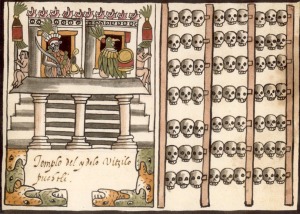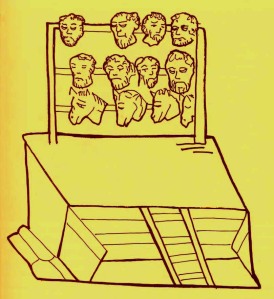What might on the following picture look like a very macabre Abacus of ancient times, is in fact a Tzompantli.

Tzompantli depicted in the Codex Duran
Tzompantlis in Mesoamerica were large racks for the display of skulls near temples or at other locations. Most of the skulls at a tzompantli were those of war captices or sacrificial victims. A lot of facts about the Tzompantlis are still speculative, starting with the name. The most probable theory – though not everywhere accepted – comes from great Frances Karttunen, which states that it’s a combination of Tzontli, meaning “skull” or “scalp” and Pantli, meaning “rack” or “wall”. Yeah, I hear you objecting “But, that would make it Tzonpantli! Where does the m come from?” That’s exactly the point, where even Mesoamericanists argue about. You may find different orthographic variants, and even very different words for it. Let’s have a look at that and have a short lesson of some basic Nahuatl:
Codex Florentino:
auh yn jtzontencon, tzompatitech conquauhço = “And his severed head they strong on the skull-rack”
Codex Chimalpahin:
auh in yehuatl yn huitzilopochtli niman ye quiteca yn itlach nimā ye quimana yn itzonpan = “And then Huitzilopochtli built his ball court; then he laid out his skull rack”
Same Codex:
oncan quimanque yn intzonpan oncan oquihtoque ynic axcan ytocayocan tzompanco = “There they laid out their skull rack where they called it Tzompanco, as its name now is.”
You can see, that versions with n and m were in use. In case you wonder about the odd versions beginning with i- or in-:
putting an i- in front of a word and taking its ending away (here -tli) is giving the word a possessive pronoun 3rd person singular.
(i)tzonpantli → itzonpan(tli), then meaning “his skull rack”
the same with in- in front is 3rd person plural. (in)tzonpantli → intzonpan(tli).
The last version is especially interesting, because the people that are building the skull rack, give it a special name.
intzonpan → Tzompanco
You will note, that the possessive pronoun falls completely away. The Suffix -co is a locative suffix and shows a place, which means that Tzompanco was now the name of the place, where they built up their rack. You can find the suffix -co and other the locatives -pan and -tlan in many city names of ancient and nowadays Mexico: Tlacopan, Texcoco, Tenochtitlan, Acapulco and even Mexico.

Tzompantli as depicted in Codex Ramirez
And yes, that is Huitzilopochtli on the left side
Back to our topic of the Tzompantli. Another fact, that is still not sure is, why exactly Tzompantlis were built. Some theories guess, that they were used to serve as vessels for the souls of the dead, that return every year. That sounds a lot like some aspects of the Día de los Muertos.
When the Spaniards walked through old MesoAmerica, they found a lot of those Tzompantlis. And after fights, the Spaniards had to get to know another, more pragmatic use of a Tzompantli. Aligned on the racks were the heads of their companions and even their horses, as we can see on this image from the Codex Florentine (originally at famsi.org):

Heads of Spaniards and their horses after a fight at Tenochtitlan
picture: famsi.org
The Aztecs had noticed very quickly, that the Spaniards were scared by bare bones, especially when beforehand they belonged to their friends. Estimates made by Spaniards were as high as 70.000 skulls at the main Tzompantli at Tenochtitlan.
A fact that is very sure however is, that the skulls were originally on the shoulders of war captives from the Flower Wars and of other sacrificial victims. Those can be for example those of a ballgame, which we will be covering in a later entry. During all times, there have been more symbolic racks as well, reliefs cut into the stone. Those can be seen at Tenochtitlan, for example. Interesting enough is, that even in the Maya Classic era – long before the Aztec formed their empire – there have been smaller versions of Tzompantli, even though the name for it on Maya is not known.
Not only in the Día de los Muertos the symbolism of the Tzompantli survived. What happens when you mix the ancient Tzompantli with a modern Christian grave is shown on the last picture with which I want to close this entry. As always you can contact me with any comment by email: judugrovee at googlemail dot com.

A Christian Tzompantli, so to say
picture: Thelmadatter/wikimedia.org/cc-by-sa




Tzompantli and basic Nahuatl
What might on the following picture look like a very macabre Abacus of ancient times, is in fact a Tzompantli.
Tzompantli depicted in the Codex Duran
Tzompantlis in Mesoamerica were large racks for the display of skulls near temples or at other locations. Most of the skulls at a tzompantli were those of war captices or sacrificial victims. A lot of facts about the Tzompantlis are still speculative, starting with the name. The most probable theory – though not everywhere accepted – comes from great Frances Karttunen, which states that it’s a combination of Tzontli, meaning “skull” or “scalp” and Pantli, meaning “rack” or “wall”. Yeah, I hear you objecting “But, that would make it Tzonpantli! Where does the m come from?” That’s exactly the point, where even Mesoamericanists argue about. You may find different orthographic variants, and even very different words for it. Let’s have a look at that and have a short lesson of some basic Nahuatl:
Codex Florentino:
auh yn jtzontencon, tzompatitech conquauhço = “And his severed head they strong on the skull-rack”
Codex Chimalpahin:
auh in yehuatl yn huitzilopochtli niman ye quiteca yn itlach nimā ye quimana yn itzonpan = “And then Huitzilopochtli built his ball court; then he laid out his skull rack”
Same Codex:
oncan quimanque yn intzonpan oncan oquihtoque ynic axcan ytocayocan tzompanco = “There they laid out their skull rack where they called it Tzompanco, as its name now is.”
You can see, that versions with n and m were in use. In case you wonder about the odd versions beginning with i- or in-:
putting an i- in front of a word and taking its ending away (here -tli) is giving the word a possessive pronoun 3rd person singular.
(i)tzonpantli → itzonpan(tli), then meaning “his skull rack”
the same with in- in front is 3rd person plural. (in)tzonpantli → intzonpan(tli).
The last version is especially interesting, because the people that are building the skull rack, give it a special name.
intzonpan → Tzompanco
You will note, that the possessive pronoun falls completely away. The Suffix -co is a locative suffix and shows a place, which means that Tzompanco was now the name of the place, where they built up their rack. You can find the suffix -co and other the locatives -pan and -tlan in many city names of ancient and nowadays Mexico: Tlacopan, Texcoco, Tenochtitlan, Acapulco and even Mexico.
Tzompantli as depicted in Codex Ramirez
And yes, that is Huitzilopochtli on the left side
Back to our topic of the Tzompantli. Another fact, that is still not sure is, why exactly Tzompantlis were built. Some theories guess, that they were used to serve as vessels for the souls of the dead, that return every year. That sounds a lot like some aspects of the Día de los Muertos.
When the Spaniards walked through old MesoAmerica, they found a lot of those Tzompantlis. And after fights, the Spaniards had to get to know another, more pragmatic use of a Tzompantli. Aligned on the racks were the heads of their companions and even their horses, as we can see on this image from the Codex Florentine (originally at famsi.org):
Heads of Spaniards and their horses after a fight at Tenochtitlan
picture: famsi.org
The Aztecs had noticed very quickly, that the Spaniards were scared by bare bones, especially when beforehand they belonged to their friends. Estimates made by Spaniards were as high as 70.000 skulls at the main Tzompantli at Tenochtitlan.
A fact that is very sure however is, that the skulls were originally on the shoulders of war captives from the Flower Wars and of other sacrificial victims. Those can be for example those of a ballgame, which we will be covering in a later entry. During all times, there have been more symbolic racks as well, reliefs cut into the stone. Those can be seen at Tenochtitlan, for example. Interesting enough is, that even in the Maya Classic era – long before the Aztec formed their empire – there have been smaller versions of Tzompantli, even though the name for it on Maya is not known.
Not only in the Día de los Muertos the symbolism of the Tzompantli survived. What happens when you mix the ancient Tzompantli with a modern Christian grave is shown on the last picture with which I want to close this entry. As always you can contact me with any comment by email: judugrovee at googlemail dot com.
A Christian Tzompantli, so to say
picture: Thelmadatter/wikimedia.org/cc-by-sa
Share this:
Related